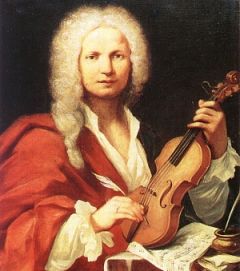
Antonio Vivaldi
(1678 - 1741)Italian composer and violinist. Son of violinist in orchestra of St. Mark's, Venice, under Legrenzi. Taught by father. Entered church, becoming priest 1703, though after 2 years never said Mass because of congenital chest complaint.
Taught violin at orphanage (Ospedale della Pieta) from 1703 and gave recitals. Published trio sonatas, Opus 1, 1705 and violin sonatas, Opus 2, 1709. First opera, Ottone in villa, produced Vincenza 1713; first Venetian opera, Orlando finto pazzo, 1714.
Was also operatic impressario in Venice and conducted and played violin in opera performances. Spent 3 years in service of Landgrave of Hesse-Darmstadt in Mantua, probably 1719-1721. Between 1721 and 1725, wrote operas for Mantua, Vicenza, Milan, and Rome. His famous Opus 8, included Le quattro stagioni (The Four Seasons), was published 1725. By this time, Vivaldi was known and admired throughout Europe.
In 1734, first collaborated with librettist Goldoni (1709-1793). In 1737, production of a new Vivaldi opera at Ferrara was forbidden by papal authorities on ground that Vivaldi was a priest who did not say Mass and had a relationship with a woman singer.
In 1738, visited Amsterdam, where his music had been published since 1711, for royal theatre centenary celebrations - his reputation stood higher in France, Holland, and England in his lifetime than it did in Venice. Despite intermittent disputes over the years, Vivaldi was still maestro at the Pieta and was still writing cantatas for performance there in 1740. In 1741, he decided to leave Venice for Vienna, presumably in search of some court appointment, but died there, being buried in a pauper's grave.
Among contemporaries who appreciated Vivaldi was J. S. Bach, who transcribed 10 Vivaldi concertos as harpsichord or organ concertos. Like Bach, Vivaldi's music fell out of favour for many years, but the 20th century, in particular since the revival of interest in authentic methods of performing baroque music, has seen it re-established. Once regarded merely as the composer of works for strings, his genius as an opera composer is now recognized (he said he wrote 94, but fewer than 50 are extant) as well as the Venetian splendour of his church music. No composer did more to establish the violoncello as a solo instrument, and he dsiplayed a keen interest in the use of unusual instruments: it its the infinite variety and invention of his work that has made it so beloved 300 years after his birth. There have been several catalogues of his work, the most recent (Leipzig 1974) by Peter Ryom (works are numbered with the prefix RV = Ryom-Verzeichnis). Principal Works:
Operas: Bajazet (Tamerlano) (1735); Catone in Utica (1737); Dorilla in Tempe (1726); Ercole sul Termodonte (1723); Farnace (1727); La fida ninfa (1732); Il Giustino (1724); Griselda (1735); L'incoronazione di Dario (1716); L'Olimpiade (1734); Orlando finto pazzo (1714); Orlando furoiso (1727); Ottone in villa (1713); Rosilena ed Oronta (1728); Rosmira (1738); Il Teuzzone (1719); Tito Manlio (1719); La verita in cimento (1720).
Published works in his lifetime: Opus 1, 12 Sonatas for 2 violins and basso continuo (1705); Opus 2, 12 Sonatas for violin and basso continuo (1709); Opus 3, L'estro armonica (Harmonic inspiration), 12 concertos for various combinations (4 violins, 4 violins and violoncello, etc.) (1711); Opus 4, La stravaganza (The extraordinary), 12 violin concertos (c. 1714); Opus 5, (2nd part of Opus 2), 4 sonatas for violin and 2 sonatas for 2 violins and basso continuo (1716); Opus 6, 6 violin concertos (1716-21); Opus 7, 2 oboe concertos and 10 violin concertos (1716-21); Opus 8, Il cimento dell' armonia e dell' inventione (The Contest between Harmony and Invention), 12 violin concertos, the first 4, in E, G minor, F, and F minor being known as The Four Seasons (Le quattro stagioni) (1725); Opus 9, La cetra (The lyre), 2 violin concertos and 1 for 2 violins (1727); Opus 10, 6 flute concertos (c. 1728); Opus 11, 5 violin concertos, 1 oboe concerto (1729); Opus 12, 5 violin concertos and 1 without solo (1729); Opus 13, Il pastor fido (The Faithful Sheperd), 6 sonatas for musette, viela, recorder, oboe or violin, and basso continuo (1737, doubtful authenticity).
The rest of Vivaldi's output is so vast that it can oly be summarized: 10 sonatas, violoncello, basso continuo; 28 sonatas, violin, basso continuo; 4 sonatas, flute, basso continuo; sonatas, 2 violins, basso continuo; concertos for various instruments (flutes, oboes, recorders, violins, bassoons, etc.) and basso continuo; over 60 concertos, sinfonias, and sonatas for strings and basson continuo; 170 concertos and sinfonias for violin, orchestra, and basso continuo; 7 concertos for viola d'amore; 28 violoncello concertos; mandolin concerto; 9 flute concertos; 2 recorder concertos; 14 oboe concertos; over 40 bassoon concertos; many concertos for 2 violins, 2 violoncellos, 2 mandolins, 2 oboes, 2 horns, 2 trumpets, etc.
Sacred music: Mass; Kyrie for double chorus; 3 Glorias; 2 Dixit Dominus; 3 Laudate pueri; 2 Magnificat; 3 Salve Regina; Stabat Mater; Juditha triumphans (oratorio, Venice 1716); also many secular cantatas, etc.
Read more on Wikipedia.